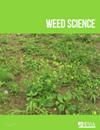In-Field Assessment of EPSPS Amplification on Fitness Cost in Mixed Glyphosate-Resistant and Glyphosate-Sensitive Populations of Palmer Amaranth (Amaranthus palmeri)
IF 2.1
2区 农林科学
Q2 AGRONOMY
引用次数: 0
Abstract
Abstract Comparing fitness of herbicide-resistant and herbicide-susceptible weed biotypes is important for managing herbicide resistance. Previous research suggests there is little to no fitness penalty from amplification of the 5-enolpyruvylshikimate-3-phosphate synthase (EPSPS) gene (a mechanism of glyphosate resistance) in Palmer amaranth (Amaranthus palmeri S. Watson) in controlled studies in the greenhouse or growth chamber. A field study was conducted in North Carolina at three locations naturally infested with A. palmeri to determine vegetative, reproductive, and germination fitness of plants with and without EPSPS amplification grown season-long with cotton (Gossypium hirsutum L.). Seed number was not correlated with EPSPS copy number. However, when plants were binned into two groups, those having an EPSPS copy number ≥2 (relative to reference genes) and those having an EPSPS copy number <2, plant fresh weight and seed number were 1.4 and 1.6 times greater, respectively, for plants with fewer than 2 EPSPS copies. Amaranthus palmeri height and seed germination, and yield of cotton, did not differ when comparing the two binned groups. These data suggest that A. palmeri plants with EPSPS amplification are relatively less fit in the absence of glyphosate, but this reduced fitness does not translate into differences in interference with cotton.EPSPS扩增对Palmer Amaranth(Amaranthus palmeri)草甘膦抗性和草甘膦敏感性混合种群适应度成本的现场评估
摘要比较抗除草剂和敏感除草剂杂草生物型的适合度对管理除草剂抗性具有重要意义。先前的研究表明,在温室或生长室的对照研究中,苋菜(Amaranthus palmeri S. Watson)的5-烯醇丙酮酰紫草酸-3-磷酸合成酶(EPSPS)基因(一种抗草甘膦的机制)的扩增几乎没有适应度损失。在美国北卡罗莱纳州三个自然发生棕毛棉的地点进行了一项野外研究,以确定有无EPSPS扩增的棉花(棉)植物的营养、生殖和发芽适应性。种子数与EPSPS拷贝数不相关。而EPSPS拷贝数≥2(相对内参基因)和EPSPS拷贝数<2的两组,EPSPS拷贝数小于2的植株鲜重和种子数分别是对照组的1.4倍和1.6倍。两组间红苋菜株高、种子发芽率及棉花产量均无显著差异。这些数据表明,在没有草甘膦的情况下,具有EPSPS扩增的棕榈草植株的适合度相对较低,但这种降低的适合度并不转化为对棉花的干扰差异。
本文章由计算机程序翻译,如有差异,请以英文原文为准。
求助全文
约1分钟内获得全文
求助全文
来源期刊

Weed Science
农林科学-农艺学
CiteScore
4.60
自引率
12.00%
发文量
64
审稿时长
12-24 weeks
期刊介绍:
Weed Science publishes original research and scholarship in the form of peer-reviewed articles focused on fundamental research directly related to all aspects of weed science in agricultural systems. Topics for Weed Science include:
- the biology and ecology of weeds in agricultural, forestry, aquatic, turf, recreational, rights-of-way and other settings, genetics of weeds
- herbicide resistance, chemistry, biochemistry, physiology and molecular action of herbicides and plant growth regulators used to manage undesirable vegetation
- ecology of cropping and other agricultural systems as they relate to weed management
- biological and ecological aspects of weed control tools including biological agents, and herbicide resistant crops
- effect of weed management on soil, air and water.
 求助内容:
求助内容: 应助结果提醒方式:
应助结果提醒方式:


